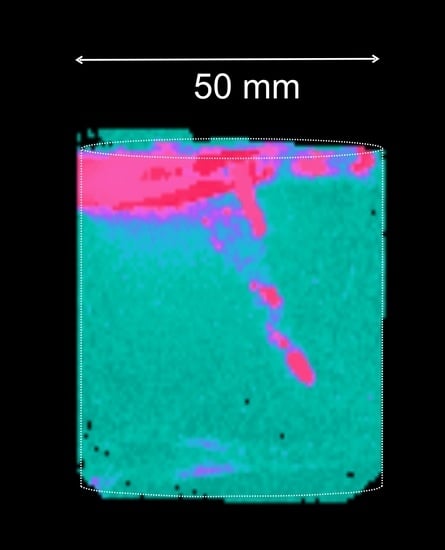Magnetic Resonance Imaging of Water Content and Flow Processes in Natural Soils by Pulse Sequences with Ultrashort Detection
Abstract
:1. Introduction
2. Results
2.1. Relaxometric Imaging, Sample S1
2.2. Comparison of MSME and ZTE, Sample S1
2.3. Comparison ZTE and UTE Sequences, Sample S2
2.4. Check for Volumetric Water Content, Samples S3 and R1
2.5. Infiltration into a Natural Soil Core, Sample S4
3. Discussion
4. Materials and Methods
4.1. MRI Methods and Image Processing
4.2. Sample S1
4.3. Sample S2
4.4. Sample S3
4.5. Sample S4
4.6. Sample R1: Homogeneity Phantom
5. Conclusions
Author Contributions
Funding
Data Availability Statement
Acknowledgments
Conflicts of Interest
Sample Availability
References
- Kirkham, M.B. Principles of Soil and Plant Water Relations; Elsevier: New Jersey, NJ, USA, 2005. [Google Scholar]
- Clothier, B.E.; Green, S.R.; Deurer, M. Preferential flow and transport in soil: Progress and prognosis. Eur. J. Soil Sci. 2008, 59, 2–13. [Google Scholar] [CrossRef]
- Yaramanci, U.; Legchenko, A.; Roy, J. Magnetic Resonance Sounding Special Issue of Journal of Applied Geophysics, 2008. J. Appl. Geophys. 2008, 66, 71–72. [Google Scholar] [CrossRef]
- Vanderborght, J.; Huisman, J.A.; van der Kruk, J.; Vereecken, H. Geophysical Methods for Field-Scale Imaging of Root Zone Properties and Processes. In Soil-Water-Root Processes: Advances in Tomography and Imaging; Anderson, S.H., Hopmans, J.W., Eds.; Soil Science Society of America, Inc.: Wisconsin, WI, USA, 2013; Volume 61, pp. 247–282. [Google Scholar]
- Keyes, S.D.; Daly, K.R.; Gostling, N.J.; Jones, D.L.; Talboys, P.; Pinzer, B.R.; Boardman, R.; Sinclair, I.; Marchant, A.; Roose, T. High resolution synchrotron imaging of wheat root hairs growing in soil and image based modelling of phosphate uptake. New Phytol. 2013, 198, 1023–1029. [Google Scholar] [CrossRef] [Green Version]
- Peth, S. Applications of Microtomography in Soils and Sediments. In Developments in Soil Science; Singh, B., Gräfe, M., Eds.; Elsevier B.V.: Amsterdam, The Netherlands, 2010; Volume 34, pp. 73–191. [Google Scholar]
- Callaghan, P.T. Principles of Nuclear Magnetic Resonance Microscopy; Oxford University Press: Oxford, UK, 1991. [Google Scholar]
- Blümich, B. NMR Imaging of Materials; Clarendon Press: Oxford, OU, UK, 2000. [Google Scholar]
- Blümich, B.; Haber-Pohlmeier, S.; Zia, W. Compact NMR; De Gruyter: Berlin, Germany, 2014. [Google Scholar]
- Haber-Pohlmeier, S.; Blümich, B.; Ciobanu, L. (Eds.) Magnetic Resonance Microscopy: Instrumentation and Application in Engineering, Life Science and Energy Research; Wiley-VCH: Weinheim, Germany, 2021. [Google Scholar]
- Hall, L.D.; Amin, M.H.G.; Dougherty, E.; Sanda, M.; Votrubova, J.; Richards, K.S.; Chorley, R.J.; Cislerova, M. MR properties of water in saturated soils and resulting loss of MRI signal in water content detection at 2 tesla. Geoderma 1997, 80, 431–448. [Google Scholar] [CrossRef]
- Haber-Pohlmeier, S.; Stapf, S.; Van Dusschoten, D.; Pohlmeier, A. Relaxation in a Natural soil: Comparison of Relaxometric Imaging, T1–T2 Correlation and Fast-Field Cycling NMR. Open Magn. Reson. J. 2010, 3, 57–62. [Google Scholar] [CrossRef]
- Balcom, B.J.; MacGregor, R.P.; Beyea, S.D.; Green, D.P.; Armstrong, R.L.; Bremner, T.W. Single-point ramped imaging with T-1 enhancement (SPRITE). J. Magn. Reson. Ser. A 1996, 123, 131–134. [Google Scholar] [CrossRef]
- Muir, C.E.; Balcom, B.J. A comparison of magnetic resonance imaging methods for fluid content imaging in porous media. Magn. Reson. Chem. 2013, 51, 321–327. [Google Scholar] [CrossRef]
- Robson, M.D.; Gatehouse, P.D.; Bydder, M.; Bydder, G.M. Magnetic Resonance: An Introduction to Ultrashort TE (UTE) Imaging. J. Comput. Assist. Tomogr. 2003, 27, 825–846. [Google Scholar] [CrossRef] [PubMed]
- Garwood, M. MRI of fast relaxing spins. J. Magn. Res. 2013, 229, 49–54. [Google Scholar] [CrossRef] [Green Version]
- Weiger, M.; Pruessmann, K.P.; Hennel, F. MRI with Zero Echo Time: Hard versus Sweep Pulse Excitation. Magn. Res. Med. 2011, 66, 379–389. [Google Scholar] [CrossRef]
- Weiger, M.; Pruessmann, K.P. MRI with Zero Echo Time. eMagRes 2012, 1, 311–322. [Google Scholar] [CrossRef]
- Weiger, M.; Brunner, D.O.; Dietrich, B.E.; Müller, C.F.; Pruessmann, K.P. ZTE Imaging in Humans. Manetic Reson. Med. 2013, 70, 328–332. [Google Scholar] [CrossRef] [PubMed]
- Mastikhin, I.V.; Balcom, B.J. Centric SPRITE MRI of Biomaterials with Short T2*. eMagRes 2007, 1, 783–788. [Google Scholar] [CrossRef]
- Marica, F.; Goora, F.G.; Balcom, B.J. FID-SPI pulse sequence for quantitative MRI of fluids in porous media. J. Magn. Res. 2014, 240, 61–66. [Google Scholar] [CrossRef]
- Li, L.Q.; Chen, Q.; Marble, A.E.; Romero-Zerón, L.; Newling, B.; Balcom, B. Flow imaging if fluids in porous media by magnetization prepared centric-scan SPRITE. J. Magn. Res. 2009, 197, 1–8. [Google Scholar] [CrossRef]
- Romanenko, K.V.; Balcom, B.J. Permeability mapping in porous media by magnetization prepared centric-scan SPRITE. Exp. Fluids 2011, 50, 301–312. [Google Scholar] [CrossRef]
- Enjilela, R.; Cano-Barrita, P.F.J.; Komar, A.; Boyd, A.J.; Balcom, B.J. Wet front penetration with unsteady state wicking in mortar studied by Magnetic Resonance Imaging (MRI). Mater. Struct. 2018, 51, 1–16. [Google Scholar] [CrossRef]
- Merz, S.; Pohlmeier, A.; Balcom, B.J.; EnJilela, R.; Vereecken, H. Drying of a Natural Soil Under Evaporative Conditions: A Comparison of Different Magnetic Resonance Methods. Appl. Magn. Res. 2016, 47, 121–138. [Google Scholar] [CrossRef]
- Covington, K.L.; Goroncy, A.K.; Lehmann, T.E.; Kou, Z.H.; Wang, H.; Alvarado, V. Analysis of ZTE MRI application to sandstone and carbonate. AIChE J. 2021, 67. [Google Scholar] [CrossRef]
- Weglarz, W.P.; Krzyzak, A.; Machowski, G.; Stefaniuk, M. ZTE MRI in high magnetic field as a time effective 3D imaging technique for monitoring water ingress in porous rocks at sub-millimetre resolution. Magn. Reson. Imaging 2018, 47, 54–59. [Google Scholar] [CrossRef]
- Weglarz, W.P.; Krzyzak, A.; Stefaniuk, M. ZTE imaging of tight sandstone rocks at 9.4 T-Comparison with standard NMR analysis at 0.05 T. Magn. Reson. Imaging 2016, 34, 492–495. [Google Scholar] [CrossRef]
- Jelinkova, V.; Snehota, M.; Pohlmeier, A.; van Dusschoten, D.; Cislerova, M. Effects of entrapped residual air bubbles on tracer transport in heterogeneous soil: Magnetic resonance imaging study. Org. Geochem. 2011, 42, 991–998. [Google Scholar] [CrossRef]
- Haber-Pohlmeier, S.; Bechtold, M.; Stapf, S.; Pohlmeier, A. Water Flow Monitored by Tracer Transport in Natural Porous Media Using MRI. Vadose Zone J. 2010, 9, 835–845. [Google Scholar] [CrossRef]
- Schindelin, J.; Arganda-Carreras, I.; Frise, E.; Kaynig, V.; Longair, M.; Pietzsch, T.; Preibisch, S.; Rueden, C.; Saalfeld, S.; Schmid, B.; et al. Fiji: An open-source platform for biological-image analysis. Nat. Methods 2012, 9, 676–682. [Google Scholar] [CrossRef] [Green Version]
- Pohlmeier, A.; Haber-Pohlmeier, S.; Stapf, S. A Fast Field Cycling Nuclear Magnetic Resonance Relaxometry Study of Natural Soils. Vadose Zone J. 2009, 8, 735–742. [Google Scholar] [CrossRef]
- Rosin-Paumier, S.; Leclerc, S.; Abdallah, A.; Stemmelen, D. Determination of the unsaturated hydrraulic conductivity of clayey soil columns using Magnetic Resonance Imaging (MRI). In Unsaturated Soils: Research and Applications; Khalil, N., Russell, A., Khoshgalb, A., Eds.; Taylor and Francis: London, UK, 2014; pp. 1155–1162. [Google Scholar]
- Rioux, J.A.; Beyea, S.D.; Bowen, C.V. 3D single point imaging with compressed sensing provides high temporal resolution R2* mapping for in vivo preclinical applications. Magn. Reson. Mater. Phys. Biol. Med. 2017, 30, 41–55. [Google Scholar] [CrossRef]
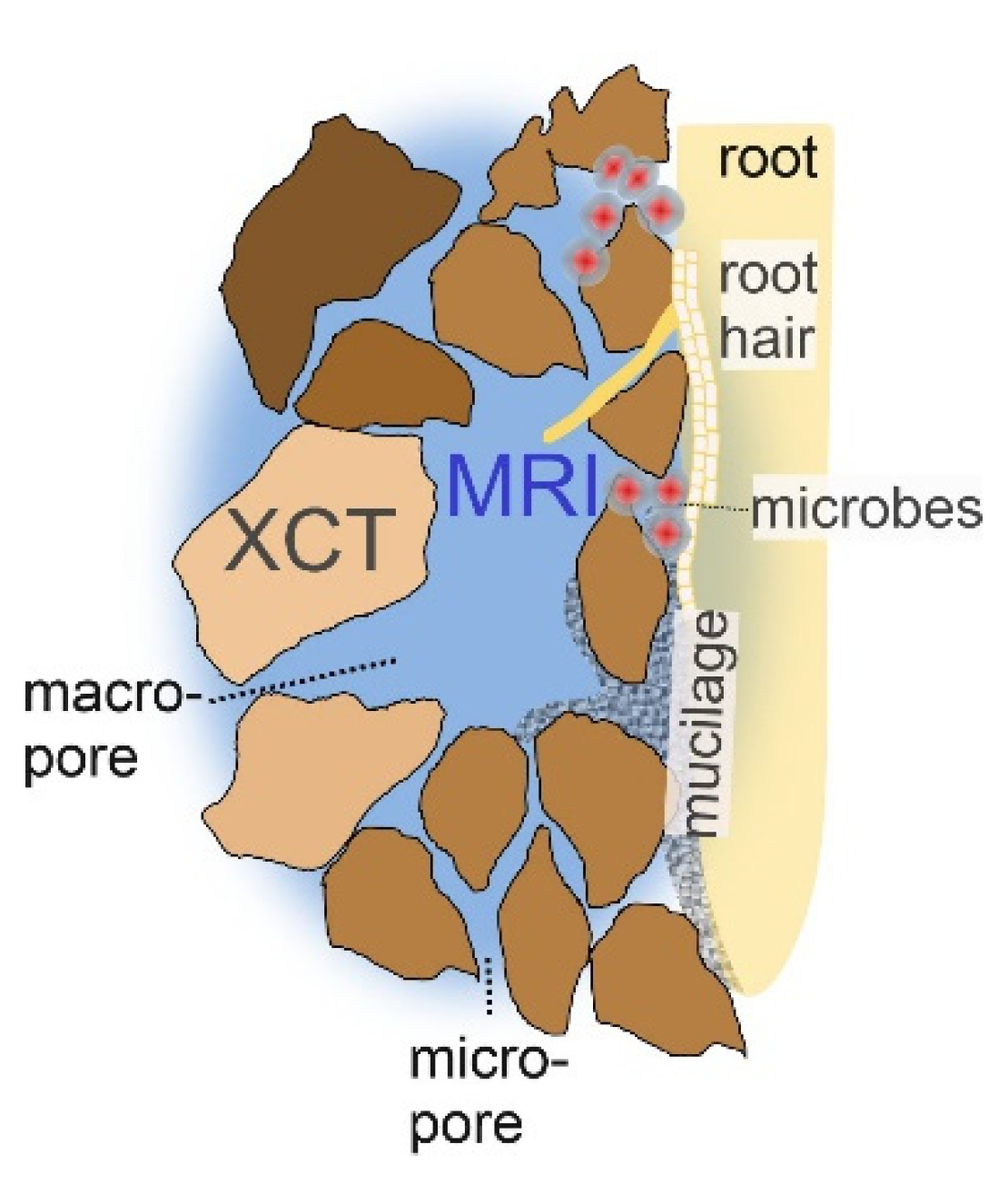


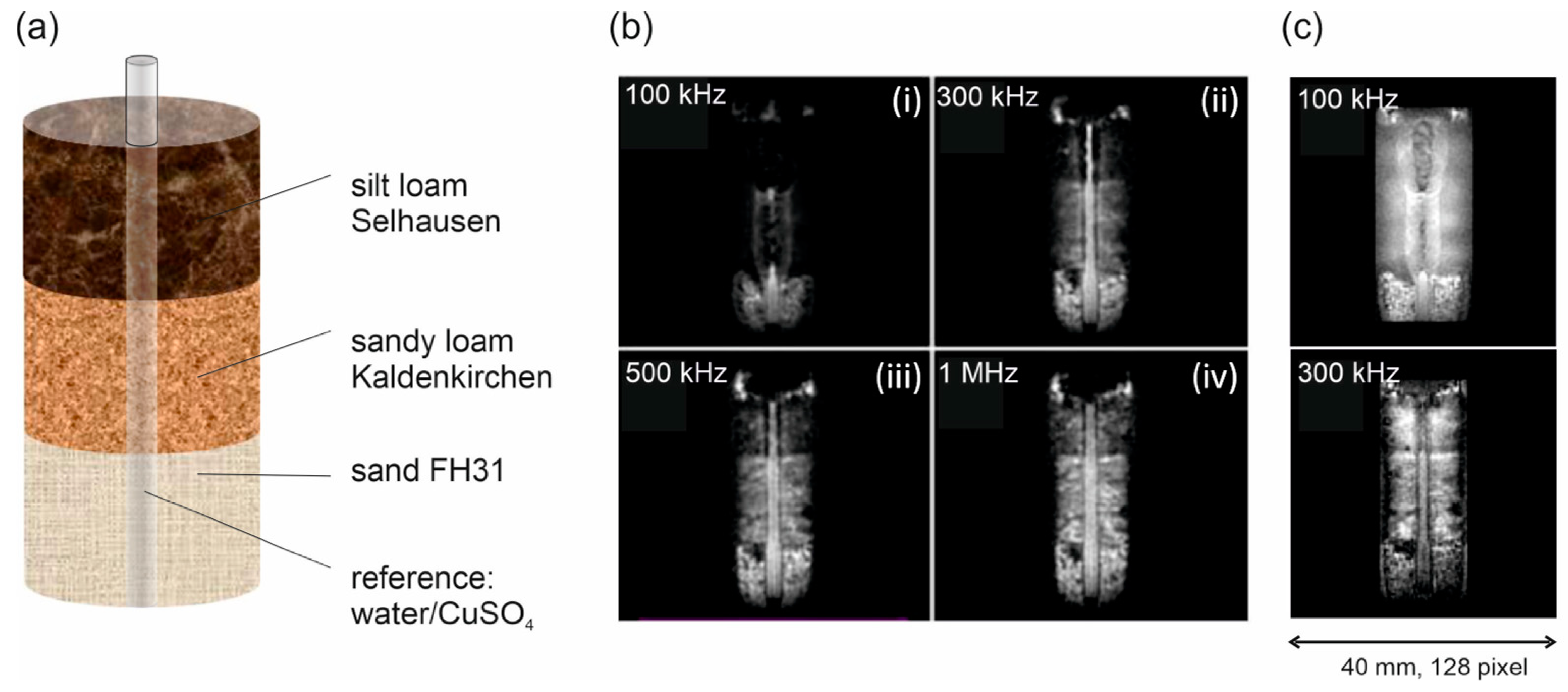
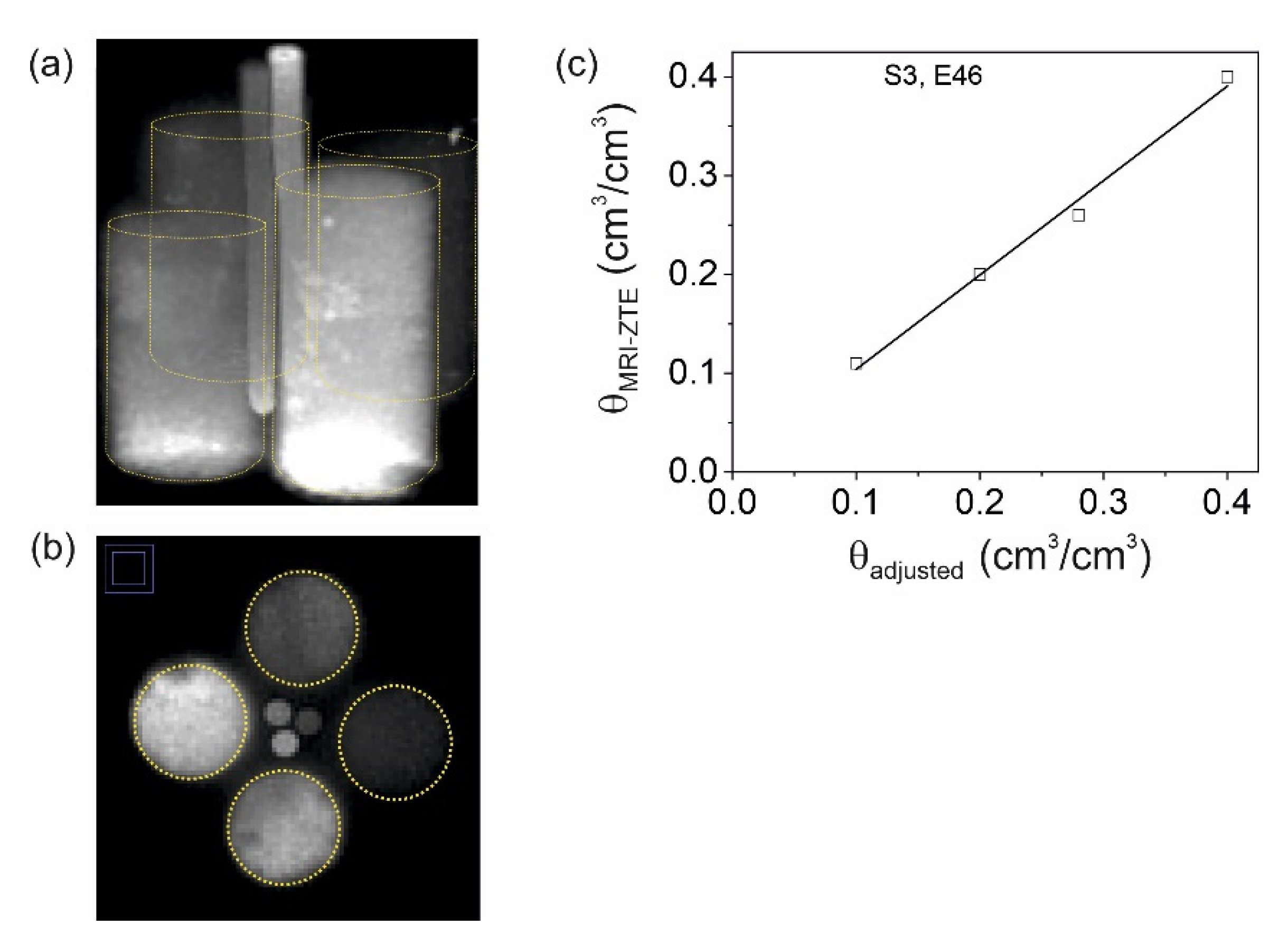
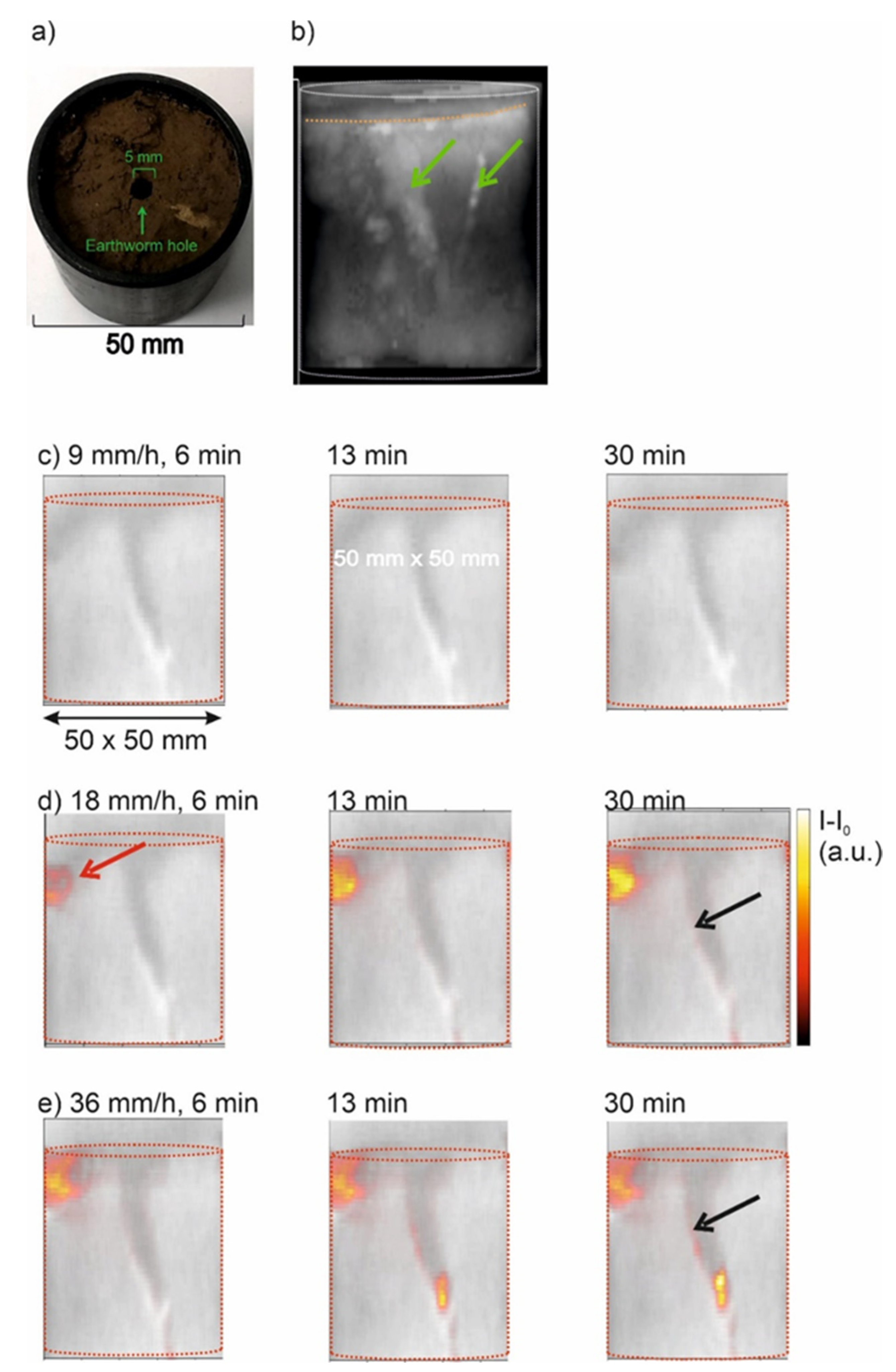
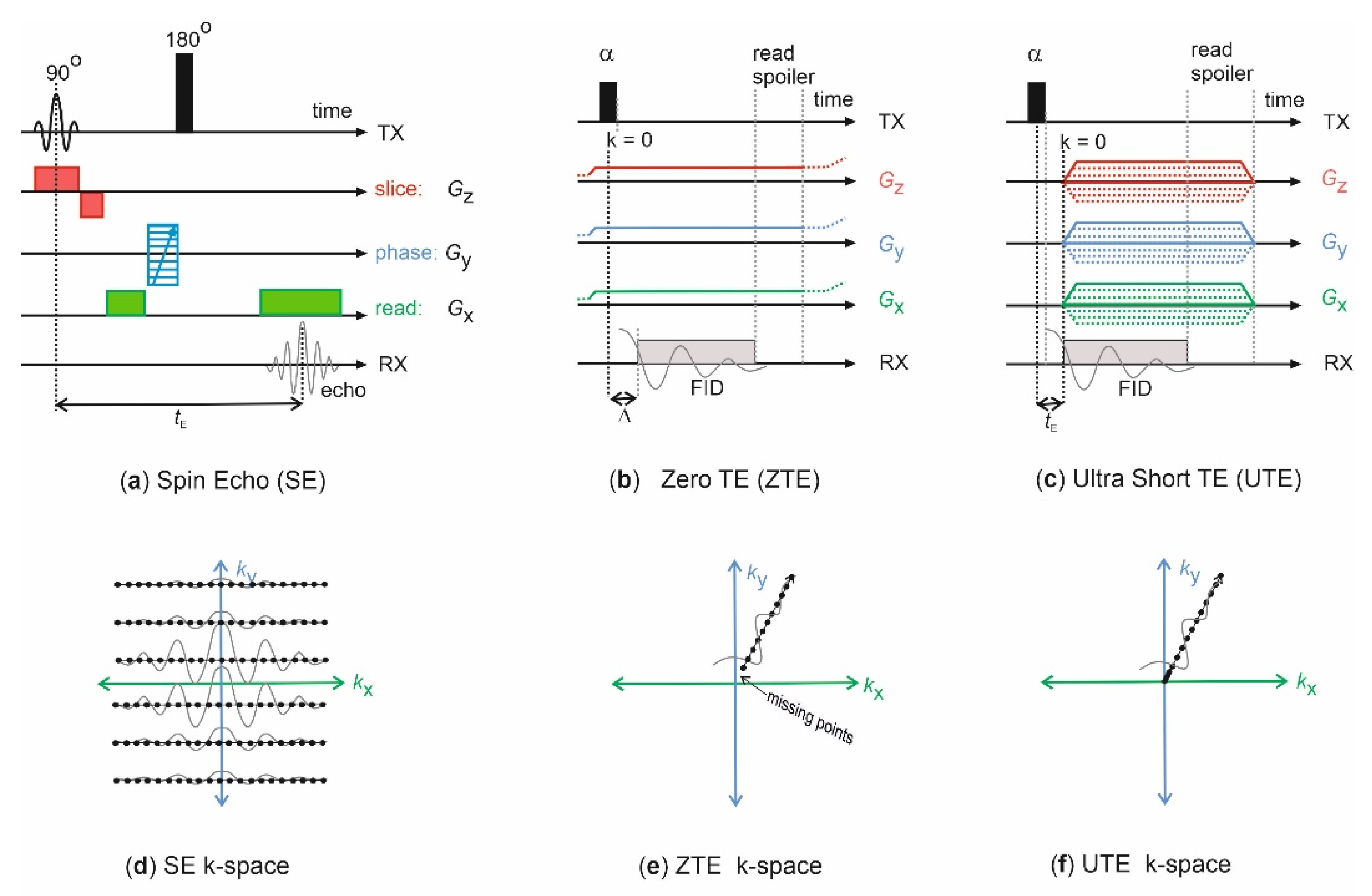
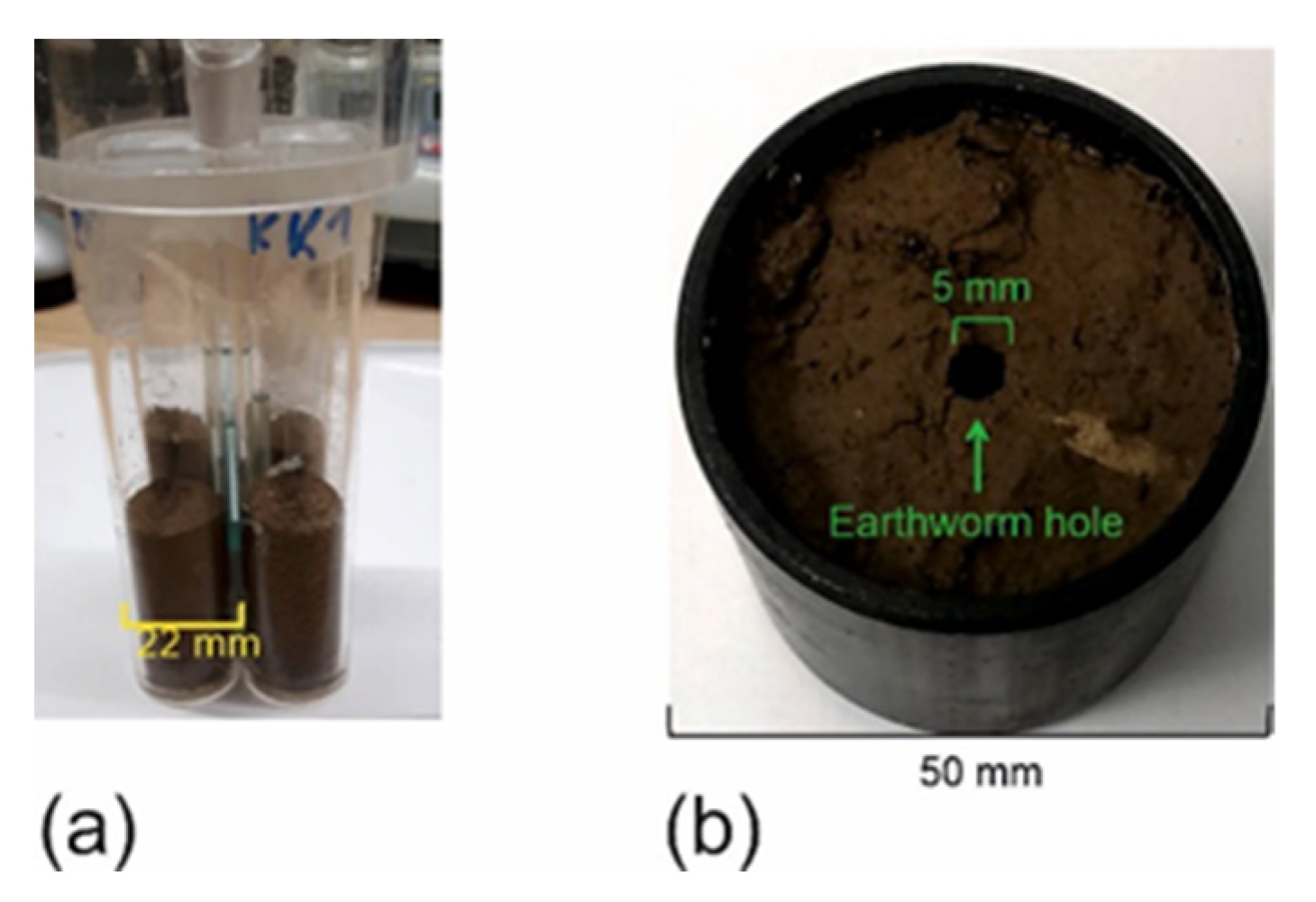
| Sample | Type | Texture (Weight-%) | Porosity (cm3/cm3) | ||
|---|---|---|---|---|---|
| Sand | Silt | Clay | |||
| S1 | Kaldenkirchen sandy loam | 73 | 23 | 4 | 0.4 |
| S2 | Selhausen silt loam | 13 | 70 | 17 | 0.45 |
| Kaldenkirchen sandy loam | 73 | 23 | 4 | 0.4 | |
| FH31, sand | 100 | 0 | 0 | 0.36 | |
| S3 | Kaldenkirchen sandy loam | 73 | 23 | 4 | 0.4 |
| S4 | Selhausen soil core, A-horizon | 13 | 70 | 17 | 0.55 |
| R1 | 0.1 M CuSO4 in 75%/25% D2O/H2O | - | - | - | - |
Publisher’s Note: MDPI stays neutral with regard to jurisdictional claims in published maps and institutional affiliations. |
© 2021 by the authors. Licensee MDPI, Basel, Switzerland. This article is an open access article distributed under the terms and conditions of the Creative Commons Attribution (CC BY) license (https://creativecommons.org/licenses/by/4.0/).
Share and Cite
Haber-Pohlmeier, S.; Caterina, D.; Blümich, B.; Pohlmeier, A. Magnetic Resonance Imaging of Water Content and Flow Processes in Natural Soils by Pulse Sequences with Ultrashort Detection. Molecules 2021, 26, 5130. https://doi.org/10.3390/molecules26175130
Haber-Pohlmeier S, Caterina D, Blümich B, Pohlmeier A. Magnetic Resonance Imaging of Water Content and Flow Processes in Natural Soils by Pulse Sequences with Ultrashort Detection. Molecules. 2021; 26(17):5130. https://doi.org/10.3390/molecules26175130
Chicago/Turabian StyleHaber-Pohlmeier, Sabina, David Caterina, Bernhard Blümich, and Andreas Pohlmeier. 2021. "Magnetic Resonance Imaging of Water Content and Flow Processes in Natural Soils by Pulse Sequences with Ultrashort Detection" Molecules 26, no. 17: 5130. https://doi.org/10.3390/molecules26175130





